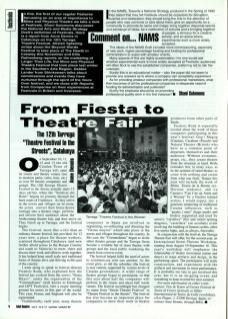On September 10, 11, 12 and 13 the old Catalan Town of Tarrega will open its streets and theatre venues (not to mention parks, cafes, bars, etc) to over 90 theatre companies and groups. The 12th Tarrega Theatre Festival in the Streets actually starts fifteen days earlier, when the ‘Sindicat del Ruire’ begins its journey through the back roads of Catalunya. As they arrive in the towns and villages on its route, the actors convert their horse-drawn carriage into a theatre stage, perform, and inform their audience about the forthcoming theatre fair, and then move on. They finish up in Tarrega, and the festival begins.
The festival, more like a fair than an ordinary theatre festival, has provided, for twelve years now, a place for theatre workers, scattered throughout Catalunya (and now further afield across to the Basque Country and south to Valencia) to meet, share and discuss their work and often to work together. It has helped keep small-scale and traditional forms of theatre alive and thriving in this part of the country.
I went along to speak to festival director Frederic Roda, who explained how the festival has evolved from the town's ‘Fiesta Mayor’, under the organisation of Els Comediants (well known to Edinburgh and LIFT Festivals), into a major meeting ground for actors in this part of the world. This year, France and England will also be represented.
Traditionally, each year, many Tarrega ‘Theatre Festival in the Streets’ companies in Spain are involved in organising, coordinating and directing the ‘fiestas mayors’ which take place in the towns and villages throughout the country. In this case, Els Comediants began to invite other theatre groups and the Tarrega fiesta became a veritable fair of street theatre, with groups and the local public wandering the streets from event to event.
The festival helped fulfil the need of actors to communicate with one another. As the event grew, so did the subsidies (the festival is now entirely supported by various levels of Catalan government). A wider range of theatre groups began to participate, so that this year about half the companies will perform in the streets and about half inside venues. The festival accordingly has changed its name from ‘Street Theatre Festival’ to ‘Theatre Festival in the Streets’. The festival has also become an important place for companies to show their work to theatre producers from other parts of Spain.
Frederic Roda is especially excited about the work of three companies participating in this year's festival. Gog i Magog (Catalan). Cacahuet (French) and Natural Theatre (British) who have as a common point of departure themselves and their audience. Without costumes, props, etc, they create theatre from the situation at hand. Roda considers this, in many ways, to be the epitome of street theatre: to come with nothing and create from what one finds. Venues this year will include the work of Mime Teatre de la Brume (ex-Decroux students), and La Casona's Can I be an Artist and a Woman by a Gaulier-trained actress. I would expect, too, a generous smattering of traditional Catalan influences, such as ‘geants i nens’ (huge masks and bodies supported and used by actors), ‘carrafocs’ (fire and rocket spitting dragons), ‘castellera’ (an acrobatic event involving the building of human castles, often five stories high), and, as always, fireworks.
In conjunction with the festival, the Tarrega Theatre Fair will offer, for the second year, an International Street Theatre Workshop, running from 19 August - 10 September. This year's workshop will emphasise the relationship of theatre movement (mime and dance) to stage artefacts and design, in the performing space. The participants will study construction, and experiment with the artefacts and movement in street performance. It is probably too late to get involved this year, but it is an ongoing event, and something to keep in mind for next summer.

